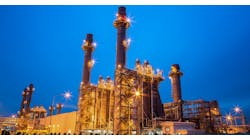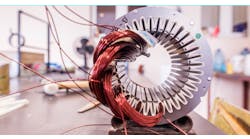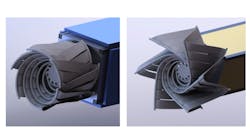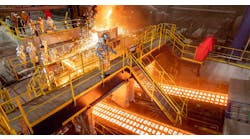When considering the PM gating system for ductile iron castings, a foundry must consider the specific features of DI, particularly its tendency to form dross defects — non-metallic inclusions in the form of refractory oxides. These inclusions are complicated by the presence of residual magnesium, which is reactive and prone to oxidation. The gating system can exert the decisive influence on the contamination of DI by preventing or promoting oxidation of the metal surface, the entry of dross into the casting, and the entrapment of air during pouring.
The following basic assumptions may be used as guides in selecting gating systems:
- Bottom-type gating systems are mostly used in castings for critical applications of substantial height to avoid the risk of dross entering the mold (Figure 22).
- Shallow and simple castings with vertical walls may be gated from the top (Figure 23) or from the side (Figure 24).
When PM castings of ductile iron are bottom-poured, the effectiveness of the riser, since it is filled with metal that has already been chilled, is reduced. Castings such as cylinders, liners, sleeves, drums, and rotors may be top poured directly into the riser. This promotes directional solidification, but makes it very difficult to avoid contamination of the castings by non-metallic inclusions.
This problem can be overcome by using a top gating system with a floating ceramic foam filter located at the bottom of the riser (Figure 25). The filter not only restricts the metal flow rate during pouring, but also removes non-metallic inclusions. When the mold fills, the filter floats upward, connecting the solidified casting to its riser and providing the conditions required for directional solidification. This eliminates shrinkage-related defects and obviates the need for an insulating riser sleeve, which provides an additional opportunity for cost reduction.
Allowing the filter to float up after the completion of pouring improves the feeding efficiency of the riser. Eliminating the pouring of metal through the filter allows the use of finer filters that are required to produce clean castings.
A top gating system using a floating ceramic filter yields a number of technical and economic benefits, such as improved casting quality, increased casting yield, and reduced energy consumption.
Gating systems with floating filters are effective in the pouring of PM cast ductile iron parts of substantial height, such as machine tool spindles. Their benefits have been confirmed by the improved mechanical properties obtained in different areas of the castings. This system makes it possible to remove the filter after pouring, therefore avoiding having to charge the spent filter and retained inclusion material back into the melting furnace.
Recommendations with respect to pouring time, which take into account the specific properties of ductile iron, are known for sand casting, but not for PM casting. An attempt was made to derive empirical relationships for the optimum pouring time for medium weight 5 - 45 kg. (10-100 lb.) DI parts cast into water-cooled permanent molds on the basis of analysis and generalization of the experimental data.
The optimum pouring time, t, providing the best quality castings, was determined by varying the dimensions of the gating system. Based on analysis of the practical data from different gating methods, it was found that the pouring time for all groups of castings coincides most nearly with the results calculated from the formula.
When calculating the pouring time, allowance must be made for the gating method used by means of coefficient K2 that varies as a function of the gating method used: 1.8, 1.6, and 1.4, respectively, for the bottom, side, and top gating systems.
The constants in the formulae reflect the fact that relatively fast top pouring and relatively slow bottom pouring give better casting quality.
Production of Large Castings
Practical utilization of the PM casting process for heavy section large ductile iron castings is possible because of relatively low cost air-cooled permanent molds manipulated by crane or overhead monorail.
Figure 27 is a schematic of a vertically parted permanent mold used for the production of ductile iron ingot molds. The permanent mold assembly consists of a pouring basin lined with a refractory, the iron permanent mold with its base, and a central sand core. Both the basin and the base have a core print in the center to soak the central tapered cylindrical core. The basin is placed on top of the central core and the mold. Before pouring, the liner is preheated to 120 - 150 °C (250 – 300 °F) by a gas torch. A carbon-containing coating is applied to protect the liner from the molten iron. Pencil ingates feed the molten iron to the casting between the core and permanent mold. Gases escape from the bottom of the core through a hole in the base. To remove the casting, the basin is lifted up from the permanent mold, then the base is removed. The finished casting has a wall thickness up to 125 mm (5 in.) and a weight of approximately 1,207 kg. (2,656 lb.).
Figure 28 is a schematic of a horizontally parted gray iron permanent mold used to make ductile iron disks. This mold is comprised of two halves, the pouring basin is installed in the cope, and central core is in the drag. The pouring basin and the drag half have a core print in their centers to hold the cylindrical sand core. The pouring basin is also lined with refractory and is coated with a carbon-based liquid. The basin fits on the top of the cope, and the cope rests on the top of the drag. Molten iron is poured into the basin and fed through the filter and segment type ingates into the casting. Gases escape through a hole at the bottom of the drag. The finished castings have a wall thickness from 50 to 100 mm (2 to 4 in.) and weight from 545 to 910 kg (1,200 to 2,000 lb.).
Lined Permanent Mold Casting
Lined permanent mold (LPM) casting, or semi-permanent mold casting, may be considered one of the technical solutions to the problem of relatively short permanent mold life, since permanent mold deterioration is a significant factor in the casting of iron. Figure 29 provides a schematic outline of the LPM process.
Characteristic of the process is that the face of the permanent mold is lined with a thin layer of sand slurry or sand mixture, depending upon the alloy to be poured. However, unlike a conventional PM, it has the advantage of extended mold life because the sand liner prevents actual contact between the mold and the molten metal. The liner thickness varies depending on casting section size and design, type of alloy to be poured, and desired productivity.
If a sand slurry liner is used, it is applied by pouring the slurry into the clearance between the PM and a pattern, having an inside configuration that follows the contour of the pattern. During slurry pouring, the permanent mold is vibrated to ensure the proper density and complete filling of the sand liner. If a sand mix is used, it is usually applied by blowing it into the clearance between the permanent mold and the pattern. Directional solidification and as-cast microstructure are regulated by sand lining thickness variations.
For low-volume heavy casting production it is recommended to use a turntable similar to that shown in Figure 30. This workstation is specifically designed to prepare sand lined permanent molds intended for the casting of 175 kg. (386 lb.) ductile iron spindles for machine tools.
The workstation consists of a turntable with four different positions. At the first position, the PM is installed and prepared for lining. An aluminum or wood pattern is then installed into the mold cavity with the clearance around the mold equal to the thickness of the future sand liner. Before installation, the pattern is coated with a graphite release agent for ease of removal once the sand lining is molded. The second position is used for pouring and vibrating the sand slurry into the clearance between the PM and the pattern to achieve the proper liner density. The third position is used for drying and curing the lined PMs. The fourth station is used for pattern removal and PM assembly. Finally, the assembled molds are transported to the pouring station.
The sand lining is used only a few times, after which the PM is re-lined for further use. For relatively thick wall spindles, the castable slurry is cast as an 18 to 25 mm (0.75 to 1.0 in.) wall thickness to achieve the proper cooling characteristics and desirable solidification structure in the castings.
The advantage of LPM is that the thin layer of sand mix or refractory eliminates direct contact between the solidified casting and the mold, resulting in not only an as-cast iron microstructure without iron carbides, but also in unlimited mold life. Energy cost is reduced because no heat treatment is necessary when iron castings are poured. It also reduces costs through less sand consumption than with conventional sand molding.
The LPM technique is currently being used to make diverse industrial ductile iron parts such as diesel engine crankshafts, machine-tool spindles and artillery projectiles of ductile iron, as well as gray iron automotive camshafts.








